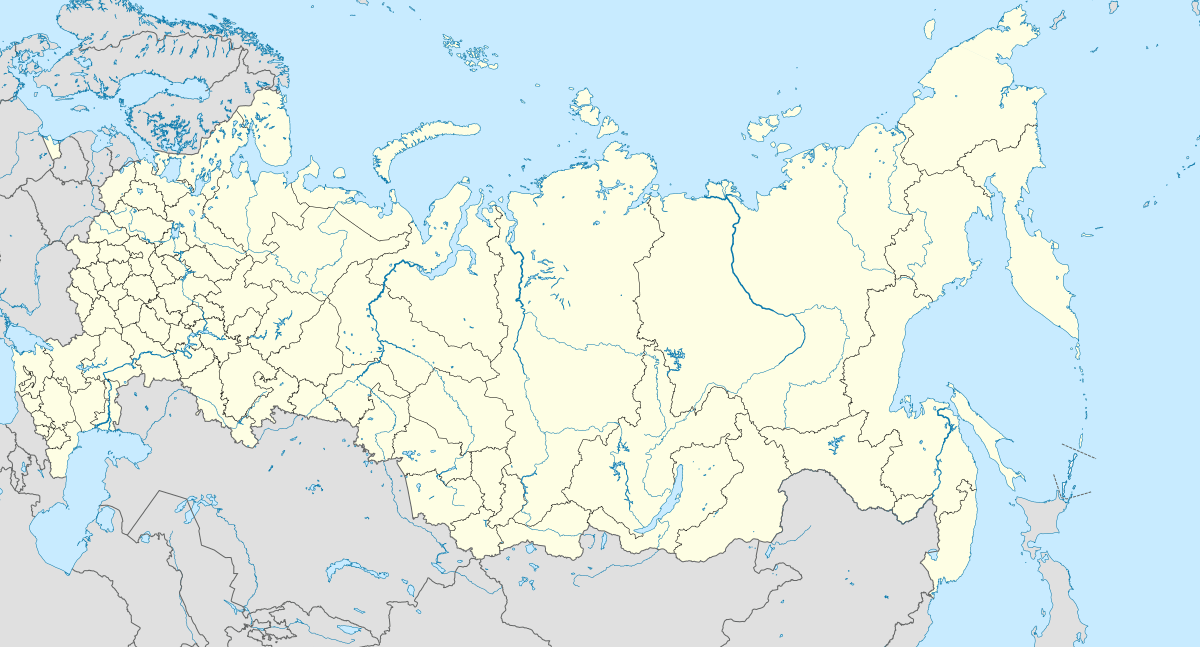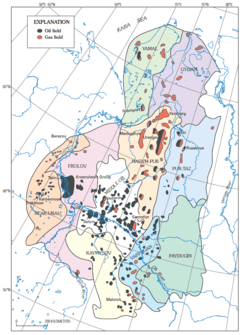Samotlor Field
Samotlor Field is the largest oil field of Russia and the sixth largest in the world,[1] owned and operated by Rosneft. The field is located at Lake Samotlor in Nizhnevartovsk district, Khanty–Mansi Autonomous Okrug, Tyumen Oblast. It covers 1,752 square kilometres (676 sq mi).[2]
| Samotlor field | |
|---|---|
 | |
| Country | Russia |
| Region | Khanty–Mansi Autonomous Okrug, Tyumen Oblast |
| Location | Lake Samotlor, Nizhnevartovsk district, |
| Offshore/onshore | onshore |
| Coordinates | 61°7′N 76°45′E |
| Operator | Samotlorneftegaz |
| Partner | Rosneft |
| Field history | |
| Discovery | 1965 |
| Start of development | 1967 |
| Start of production | 1969 |
| Peak year | 1980 |
| Production | |
| Current production of oil | 332,782 barrels per day (~1.658×107 t/a) |
| Year of current production of oil | 2013 |
| Estimated oil in place | 4,000 million barrels (~5.5×108 t) |
| Producing formations | Cretaceous ages |

History
The field was discovered in 1965. Development started in 1967 and first oil was produced in 1969.[1][2] Discovery of this field had changed Nizhnevartovsk from a small nearby village into a busy oil city as Samotlor used to be the most important oil production base of the Soviet Union. After breakup of the Soviet Union the field was owned by Samotlorneftgaz and TNK-Nizhnevartovsk, which later formed TNK-BP.[3]
Over the all development period a total of 2,086 well clusters (containing more than 17,000 wells) have been built and about 2.6 billion tons of oil has been produced.[1][2] The peak production occurred in 1980 when Samotlor produced 158.9 million tons of oil (7 Mbbl/d or 1.1×106 m3/d).[2] The production has been in decline ever since, although according to TNK-BP the field production has stabilized over the past last years after.[1]
Reserves
The in-place oil reserves of the Samotlor field were equal to 55 billion barrels (8.7×109 m3) and as of 2009 estimated at 1 billion barrels (160×106 m3). The proven reserves are approximately 44 billion barrels (7.0×109 m3).[4] The field is 80% depleted with water-cut exceeding 90%.[1]
At the end of the 1990s, production rate dropped to 300,000 barrels per day (48,000 m3/d).[5] However, through an aggressive exploration program and application of cutting-edge technologies TNK-BP had raised production up to 750,000 barrels per day (119,000 m3/d).[1] Up to 2012, TNK-BP plans to invest US$1 billion per year for maintaining oil production in it at the level of 30 million tons per year.[4]
In media
The oil processing plant in Nizhnevartovsk is the scene of (but referred to by location rather than directly by name) the beginning of Tom Clancy's 1986 novel Red Storm Rising.[6]
References
- "TNK-BP's Samotlor Field Declared the World's Sixth Biggest". OilVoice. 22 August 2009. Retrieved 14 June 2010.
- "Samotlor". TNK-BP. Retrieved 14 June 2010.
- Lynch, Michael (13 April 2009). "TNK-BP planning to produce Samotlor for another 90 years". Gerson Lehrman Group. Retrieved 14 June 2010. Cite journal requires
|journal=(help) - "TNK-BP to Invest $1 bln in Samatolor Field". Oil & Gas Eurasia; TNK-BP. Eurasia Press, Inc. 28 May 2001. Retrieved 14 June 2010.
- "TNK to revive Samotlor oil field". The PMA Online Power Report. Alexander's Gas & Oil Connections. 28 May 2001. Archived from the original on 18 September 2009. Retrieved 14 June 2010.
- http://www.bookrags.com/studyguide-red-storm-rising/chapanal001.html
Sources
- Kramer, Andrew E. "Mapmakers and Mythmakers: Russian Disinformation Practices Obscure Even Today's Oil Fields," New York Times (1 December 2005): C1.